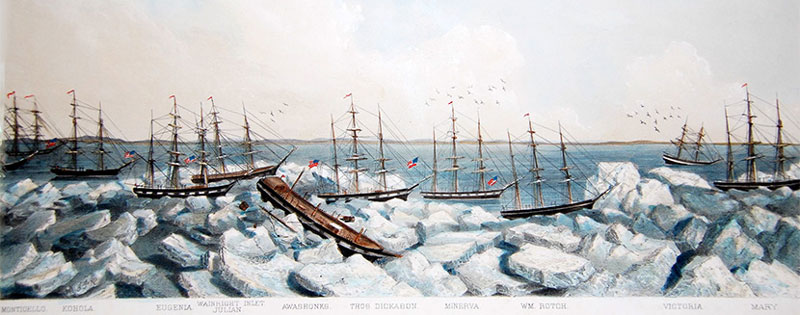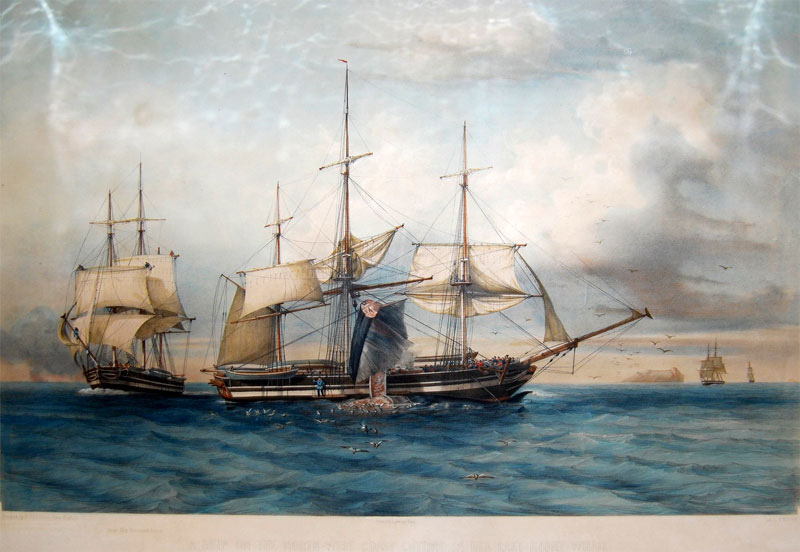
By Bradley W. Barr, Ph.D., NOAA Office of National Marine Sanctuaries Maritime Heritage Program, Co-Principal Investigator and Chief Scientist

Abandonment of the whalers in the Arctic Ocean, September 1871, including the Monticello, Kohoa, Eugenia, Julian, Awashonks Thom Dickason, Minerva, Wm. Rotch, Victoria, and Mary. Wainwright Inlet is in the background. Image courtesy of Nof Ted and Ellie Congdon, Huntington Library. Download larger version (jpg, 126 KB).
In August 1871, 40 whaling ships from Hawaii, New England, and California had come to an area north of Wainwright Inlet along the Chukchi Sea coast in the pursuit of the bowhead whale. The pack ice being close to shore that year left little room for maneuvering of the fleet. The whaling captains counted on a wind shift from the east to drive the pack out to sea as it had always done in years past.
Instead of moving offshore, the ice pack trapped 33 ships between ice and shore in a constantly and quickly diminishing stretch of open water with no chance to sail out. Concluding that escape with their ships was impossible, the captains elected to evacuate all 1,219 men, women, and children by way of the ships' whaleboats. In these frail craft, the ships' crews dragged the whaleboats across this jagged landscape of ice to open leads, then rowed 90 miles south past Icy Cape where they were rescued by seven other whaling ships whose passage south was unhindered by the ice.
Although the journey required them to row through ice-choked and heavy seas, no lives were lost in this mass abandonment. Of all the ships abandoned to the Arctic winter of 1871, only one ever sailed again. The remaining 32 vessels were crushed by the ice and sunk or burned near Point Belcher. A similar fate awaited 12 more whaling ships in precisely the same location in 1876, but this time the survivors of these ice-bound vessels were not all as fortunate, with 47 men losing their lives stranded on the ice.

Cutting-in a whale. Image courtesy of Ted and Ellie Congdon, Huntington Library. Download larger version (jpg, 2.6 MB).
The loss of approximately 50 whaling ships within a five-year period in the 1870s is widely attributed as one of the major causes of the demise of commercial whaling in the U.S., which represented one of the most important elements of the American economy of the 19th Century. These losses are considered highly significant events in the history of American whaling, and this part of the Chukchi coast a place of unparalleled importance in the global whaling heritage landscape.
What may remain of this shipwrecked whaling fleet is unknown. The area remains largely unexplored, inadequately mapped, and while the historical documentation of the events of 1871 and 1876 is extensive, the ultimate fate of these many whaling ships, abandoned and lost in the latter part of the 19th Century, remains a mystery. The final chapter of this story has yet to be written.
The Arctic is a place of great fascination and allure for many people who see it as remote, cold, and mysterious, harsh and unforgiving, a place synonymous with “wilderness.” It is a place that has a rich, compelling history of exploration. It is a place where aboriginal whaling continues by the Iñupiat, carrying on traditional cultural practices that have been conducted for more than a thousand years. It is also now a place where, as a result of a warming climate, other human activities, only occasionally conducted in the Arctic in the past (such as commercial shipping and oil and gas exploration and production) are rapidly emerging as economic opportunities, but also potential threats to both natural and cultural resources of the Arctic.

Encountering polar bears along the beach of the survey area was an everpresent danger whenever people were sent ashore. Scientists and crew aboard R/V Ukpik keep a close watch over the shore party deploying the magnetometer base station until they return. Image courtesy of NOAA/ONMS/Hans Van Tilburg. Download larger version (jpg, 3.3 MB).
Clearly, collected mapping information would be essential for informing and guiding emerging economic development opportunities so that they can be achieved without diminishing the rich heritage resources present in this globally-significant place. However, information obtained through this mission will also be of value to a wider audience, potentially including, but certainly are not limited to, much-needed data for updating NOAA’s Arctic navigation charts, and possibly first steps toward a collaborative federal agency initiative to conduct a more extensive baseline archaeological survey for the Chukchi Sea.
While preserving our maritime heritage may not be one of the most prominent of NOAA’s many important missions and mandates, it is one that engenders great public interest and attention. Heading to the Arctic in 2015 in search of the “Lost Fleets” – to write the final chapter of this compelling story – is likely to not only help NOAA accomplish this mandate, but to excite the imagination of the American public. We are a maritime people, connected to the sea. It is part of who we are as Americans. The Arctic is a place of considerable importance, a place that is experiencing great change, and a frontier that is disappearing.
Writing the last chapter of the saga of the “Lost Whaling Fleets” is one way we can save this exceptional place so that the next generation can experience some of the excitement and wonder the Arctic has engendered in so many of us.
For more information on the 1871 abandonments, visit, "The Disaster of 1871: The Ice Takes its Toll."
For more information on the 1876 abandonments, visit "History Repeats Itself: The Disaster of 1876."